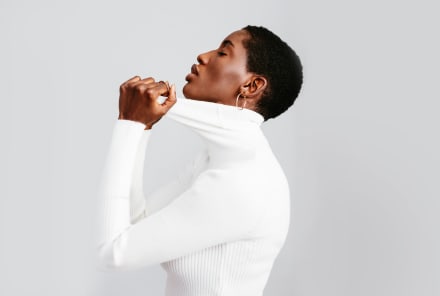Advertisement
Everyone Has A Grief Archetype — Here's How To Figure Out Yours


At one point or another, grief is a reality for everyone. But it's not limited to the loss of a loved one. Grief happens when life changes.
It's what Annette Childs, Ph.D., a licensed psychotherapist and award-winning author, calls collective grief—the huge losses that millions of people are experiencing at familial, local, national, and global levels.
How we navigate our grief is highly individual. But understanding that our grief journey has been shared in some way by those around us can be incredibly reassuring. And the first step is knowing your grief archetype.
What are grief archetypes, you ask?
Childs describes her role as a grief therapist as a companion to those who feel lost in the woods. "I have often found that the most reliable light to shine into the darkness is the one gathered from the collective wisdom of those who have walked before us," she says.
Over the course of her 25-year career, she has noticed distinct patterns among her grieving clientele—well-traveled "footpaths" that can help people feel a little less lost. To reflect these patterns, she created four grief archetypes.
"At its most basic level, exploring grief within the content of an archetype is a simple way to help us recognize shared patterns in the grieving process," Childs explains. That's important because it's common to feel alone in our experiences when we grieve.
"There's no 'right' way to do grief, but there are known pathways to take, and the archetypes can help you shine a light on which path you may be taking and give you insight into others that you may be well served to veer toward in the future."
That's the beauty of the archetypes—they aren't set in stone, nor is there any kind of hierarchy. "They aren't a steel box that we have to stay in," says Childs. "They're more like a street we've chosen to take, and at any time along the way, particularly with education and support, we're likely to merge into a different lane and change up our coping patterns."
The Pilgrim
More than half of Childs' clients fit the pilgrim archetype. In general, pilgrims gravitate toward supportive relationships, such as therapy, AA, or faith-based support. They're gentle and trusting by nature, and during their time of loss, they become wary and unsure of the path ahead.
They don't typically seek grief therapy as a quick fix but rather because they want companionship on the journey—someone to help them sift through the mess that grief leaves behind.
In the therapy setting, pilgrims tend to bring their whole hearts and souls into the healing process and form deep and long-lasting relationships with the helpers in their lives. A pilgrim may arrive into therapy due to loss but will likely stay there as they learn and grow beyond that loss.
Do you tend to feel a connection to people in your world that others may not even notice—like the favorite checker you always go to at the grocery store who feels like family? If so, you could be prone to the path of a pilgrim.
The Villager
The villager archetype is aptly named. Villagers like to have a sturdy support system in place. They tend to have a tool kit for managing emotions, but they like the idea of adding to their collection. For villagers, the hardest part of grief is that it tends to catch them off guard. They turn to therapy to minimize the chances of that level of unpreparedness ever happening to them again.
Villagers are in the habit of taking notes from past experiences. They make it their goal to be prepared for whatever may come. With their straightforward and logical approach to the future, they tend to serve as good examples to others.
Are you the type to always have a tissue handy or a flashlight in your car? If so, you may fit the villager archetype.
The Pioneer
Childs has seen the pioneer archetype the least during her practice. Pioneers adapt to grief by learning how to move with it—and sometimes through it or around it. Pioneers are doers and shakers and they tend to use the losses of their life as fuel to propel them up and out of the darkness of grief as quickly as possible.
Movement is key to integrating grief into their world, so pioneers are most likely to experiment with things like exercise, travel, and new hobbies.
This tendency doesn't mean that pioneers bypass any of the rigors of loss. They just move through it differently, tearing off bits of their loss in small pieces to avoid wallowing in heavy emotions for too long.
If your reaction to grief is reading four different self-help books on loss, listening to an audiobook on resilience, hosting a Friday-night dinner party, and then getting up early the next morning to catch a seminar on mala beading your way to happiness, you could very well fit the pioneer archetype.
The Voyager
A seeker at heart, the voyager archetype is someone intent on mining for gold in the darkness of loss. Voyagers are always looking to the far-off horizon as a way to make meaning out of their difficulties.
Voyagers look inward too, seeking a way to force growth from what can feel like the arid landscape of loss. They have a willingness to really sit with grief and allow it to take them where it will. That willingness means voyagers tend to not only find light on their own journey but sometimes to lead others with that light as well.
Are you the kind of person who keeps a dream journal and really pays attention to the symbolism of your nighttime impression? Do you find meaning in what others would consider coincidence? If so, you might be following the path of the voyager.
The value of knowing your grief archetype
If you can imagine the experience of grief as being lost in the woods on a dark night, the value of an archetype—a footpath—immediately becomes clear. Navigating grief from the context of these four archetypes is like having a compass at a time when we feel our most lost and alone.
Archetypes in general bind us to universal symbols, helping us find strength in our patterns and allowing us to recognize potential pitfalls. "Recognizing these patterns doesn't make our grief disappear, nor does it shorten the duration of the experience," says Childs. "But it does allow us to move forward with a bit more certainty, knowing that others have traveled the same route."
And remember, the greatest value of learning your grief archetype, particularly during a time when experiencing grief in multiple forms is more commonplace than ever, is understanding that you aren't alone in your experience.

















